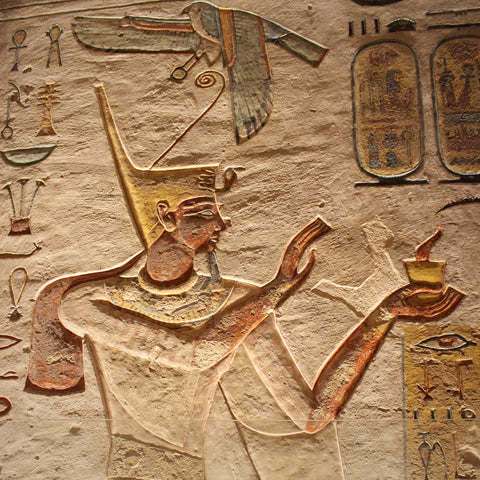
We awoke this morning to a pastel view of The Valley of the Kings, across the River Nile, in Luxor, Egypt. We were eager to explore the hot and dusty limestone crevices of this hidden valley—a place where pharaohs, queens and (invited) noblemen have lain buried for thousands of years.

These desert mountains are certainly an inhospitable place for nosy on-lookers or ruthless grave robbers. The pharaohs (and their teams who planned their funerals) believed that this desolate place would provide privacy and protection until their royal souls could come back and re-animate their carefully preserved corpses. But people did find their graves—grave robbers, mercenaries and scholars—some as far back as antiquity and some in the Twentieth Century.
Though the environment is very dry and very hot (112° Fahrenheit today), it is the perfect climate for preserving mummified bodies for centuries, even millennia.

Shown here, a painted wall carving from the Tomb of Pharaoh Rameses III (1184-1153 BC). The king is shown wearing the pharaonic crown of Lower (that is Northern) Egypt. Significant images, cartouches and hieroglyphs surround him.

The same pharaoh, Rameses III, is shown here wearing the crown of Upper Egypt (which is to the South, up the River Nile). There were no accidents or artistic license afforded the artists who designed and decorated tombs. Every image, costume, animal, god or goddess, hieroglyph or cartouche was intentional and religiously meaningful.

I'm not sure what the three-headed snake (with four feet) represents, but it had to have some significance.

Shown here, the Goddess of the Night, Nut, is stretched across the ceiling of the Tomb of Rameses IV (1155-1149 BC). Nut is shown swallowing the Sun (the God Ra). Every day the cycle repeated: Nut would consume the Sun at dusk and it would be reborn the next morning at dawn. The never-ending cycle of life and rebirth continued, on-and-on.

The walls of the Tomb of Rameses IV are covered in hieroglyphs.

Desecration of tombs was an occasional, perhaps common occurrence. Sometimes a new pharaoh would chisel-out the images (or names) of a predecessor he didn't like. Rameses II notoriously hated King Hatshepsut (who, though she was a woman, crowned herself King). Invading forces—sometimes bringing their new religion—also attempted to sever Egypt's ties to the past (and their pagan religion). Fourth Century Byzantine Christians from Constantinople sought to accelerate the spread of Christianity which had advanced throughout much of Egypt. And Muslim forces in the Seventh Century did not condone what looked like idol worship or multi-deity paganism. Even today, religious zealots (of any persuasion) are capable of destroying ancient works of religious art, all in the name of their chosen theology.
The painted cross, shown above, was painted upon the wall of Rameses IV's tomb. It was how these Early Christians attempted to replace the old religion with their new theology.
Though our Greenwich Village store is now permanently closed, LEO Design is still alive and well! Please visit our on-line store where we continue to sell Handsome Gifts (www.LEOdesignNYC.com).
We also can be found in Canonsburg, Pennsylvania at The Antique Center of Strabane (www.antiquecenterofstrabane.com).
Or call to arrange to visit our Pittsburgh showroom (by private appointment only). 917-446-4248

